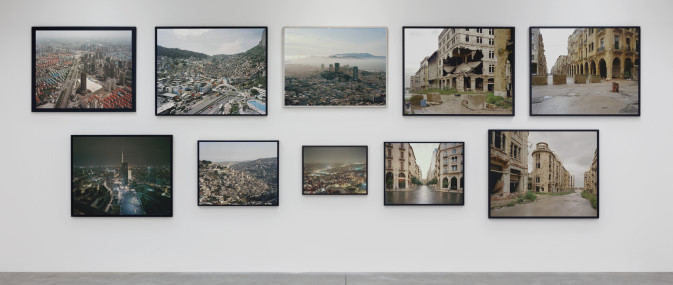

Bio
Gabriele Basilico
Gabriele Basilico (Milan, 1944 – Milan, 2013) began taking photographs in the early 1970s. He is one one of Italy’s most renowned photographers, who over the years recorded many cities, among them Milan, Beirut, Rio, Jerusalem, Moscow, Istanbul, New York, Shanghai and San Francisco.
After graduating in architecture in 1973, Basilico began a continuous documentation of the city and urban landscape. His first photographic project was Milano ritratti di fabbriche 1978-80 [Milan: Portraits of Factories 1978-80], whose subject was the Milanese industrial suburbs. With his 1984-5 project Bord de mer, he was the only Italian to take part in the Mission Photographique de la DATAR, an extensive French government project that commissioned an international group of photographers to document the transformation of the French landscape. In 1991 he went on an international mission to Beirut, a city devastated by the civil war that lasted fifteen years. This resulted in the 1994 book Basilico / Beyrouth.
He also participated in numerous documentary projects in Italy and abroad, which led to exhibitions and books, including Porti di Mare (1990), L’esperienza dei luoghi (1994), Sezioni del paesaggio italiano (1998), Interrupted City (1999), Cityscapes (1999), Scattered City (2005), Intercity (2007); Silicon Valley (2011), commissioned by the San Francisco MoMA; Roma 2007, prepared on behalf of the 2008 International Photography Festival; and Mosca verticale (2008), a photographic project on Moscow’s urban landscape taken from the top of the seven Stalinist towers. In 2010 he photographed Istanbul and Shanghai. In 2011 he was invited to participate in a further photographic mission in Beirut, later holding an exhibition of the work at the Brazilian Oi Futuro Foundation in Rio de Janeiro. The same year he worked on Italia. Capolavori del Rinascimento. In 2012 he took part in the XIII International Architecture Exhibition in Venice with the project Common Pavilions, in collaboration with the Basel studio Diener & Diener Architekten.
Gabriele Basilico’s exhibitions and books provide a constant and important moment of reflection on landscape photography. His research, which goes well beyond the boundaries of mere documentary photography, is in fact an obligatory point of reference for those involved in photography and urban planning today.
Since 1977 his work has been exhibited in private galleries, museums and institutions all over the world. Among his last solo shows were those held at: Archaeological Museum of Aosta (2018), ICO Museum, Madrid (2017), Unicredit Pavilion, Milan (2015), Galleria Civica, Modena (2014), MAXXI, Rome (2013), Villa Pignatelli, Naples (2012), MUAR, Moscow (2011), Stelline Foundation, Milan (2010), Palais de Chaillot, Paris (2008), SF MoMA, San Francisco (2008), Maison de la Photographie, Paris (2006), Fundaçao Calouste Gulbenkian, Lisbon (2006), Stedelijk Museum, Amsterdam (2000). Group shows include: PoliArte (The Art of Arts), Galleria Enrico Astuni, Bologna (2019); Extraordinary Visions. L’Italia ci guarda, MAXXI, Rome (2016); Milanopiazzaduomo, Museo del Novecento, Milan (2015); Themes & Variations. The Empire of Light, Peggy Guggenheim Foundation, Venice (2014); Concrete. Photography and Architecture, Foto Museum, Winterthur; (2013); Addio anni settanta. Arte a Milano 1969-1980, Palazzo Reale, Milan (2012); Trans photographiques, Palais des Beaux-Arts, Lille (2011); Il furore delle immagini, Fondazione Bevilacqua La Masa, Venice (2010).
He has participated in important exhibitions, among them the Venice Biennale (1995, 2007, 2012); the Gwangju Biennale, Gwangju, South Korea (1997); FotoFest 1998: 7th International Month of Photography, Houston (1998); Rencontres Internationales de la Photographie, Arles (1987, 1997, 2002, 2015).
His works are part of important collections, including: Venice Biennale Historical Archives of Contemporary Arts (ASAC), Venice; Arquivo de la Camera Municipal, Lisbon; Bibliothèque Nationale, Paris; Caisse des Dépôts et Consignations, Paris; Canadian Center of Art, Montreal; Deutsche Architektur Museum, Frankfurt; Deutsche Bank, Milan; DG Bank, Frankfurt; Die Neue Sammlung, Munich; Fondation Cartier pour l’Art Contemporain, Paris; Cini Foundation, Venice; International Center of Photography, New York; IVAM, Valencia; Kreditanstalt für Wiederaufbau, Frankfurt-Berlin; Kunsthaus, Zurich; Mark Getty – Getty Image, London; Merrill Lynch, London; Musée de l’Elysée, Lausanne; Castello di Rivoli Museum of Contemporary Art (Turin); MART, Rovereto; Museo de Bellas Artes, Bilbao; Museum of Contemporary Photography, Cinisello Balsamo (Milan); Centro de Arte Reina Sofía, Madrid; Center Georges Pompidou, Paris; MAXXI, Rome; MoMA, New York; SF MoMA, San Francisco; Solidère, Beirut; Stedelijk Museum, Amsterdam.
In an interview, Gabriele Basilico once said: “Of course I take photographs in relation to the principle and aesthetic experience of ‘vision’. In this sense I’m fully a photographer. But it is also true that photography, not only as a language, has been part of the art world for quite some time, and quite rightly so. However, I am convinced that the photograph as an item in the enormous field of artistic research is too reductive an idea: it’s one thing to use photography as a language for communicating a work conceived in a different way (for example, an installation), but quite another to think ‘photographically’ when interpreting reality.”

